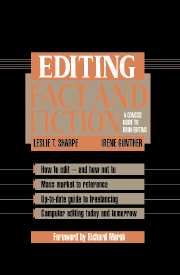Book contents
- Frontmatter
- Contents
- Foreword
- Acknowledgments
- Introduction
- Chapter 1 Who (and What) Is an Editor?
- Chapter 2 Fact or Fiction? Finding Your Niche
- Chapter 3 Principles to Edit By
- Chapter 4 The Editor's Senses
- Chapter 5 The Editor's Sensibility
- Chapter 6 A Guide to Editorial Freelancing
- Chapter 7 Electronic Editing Today and Tomorrow
- Chapter 8 Tools of the Trade and How to Use Them
- Index
Chapter 7 - Electronic Editing Today and Tomorrow
Published online by Cambridge University Press: 21 September 2009
- Frontmatter
- Contents
- Foreword
- Acknowledgments
- Introduction
- Chapter 1 Who (and What) Is an Editor?
- Chapter 2 Fact or Fiction? Finding Your Niche
- Chapter 3 Principles to Edit By
- Chapter 4 The Editor's Senses
- Chapter 5 The Editor's Sensibility
- Chapter 6 A Guide to Editorial Freelancing
- Chapter 7 Electronic Editing Today and Tomorrow
- Chapter 8 Tools of the Trade and How to Use Them
- Index
Summary
Ever since the advent of computer technology, there has been talk about how it will revolutionize the publishing industry, simplifying both the editing and production of books–and perhaps even eliminating books as we know them altogether. Books are still very much with us, although, as we shall see in the last section of this chapter, the manner and medium in which they are produced and distributed are already undergoing massive change. Computers, with their enormous capacity to store, retrieve, manipulate, reproduce, and transmit information, have already had an enormous impact on publishing. Most notably their use has allowed publishers to keep more of the typesetting function in-house, in some cases bypassing the typesetter completely and taking the author's keystrokes–or those of an in-house word processing operator–all the way to film or camera-ready copy to be used by the printer.
When typesetters are eliminated, the production process is known as desktop publishing. For newspapers, desktop publishing is a natural and is now the norm; newspapers are produced more quickly and efficiently than before because everyone involved in the process, from reporters to designers to editors, is hooked into the same computerized system, and copy is transmitted back and forth electronically without ever appearing on paper until the newspaper is printed. Books are, however, a different matter. Each is a separate entity, with its own set of editorial and production problems; each comes from a different source (which could be the author's computer, word processor, typewriter, or even pen).
- Type
- Chapter
- Information
- Editing Fact and FictionA Concise Guide to Book Editing, pp. 174 - 195Publisher: Cambridge University PressPrint publication year: 1994



